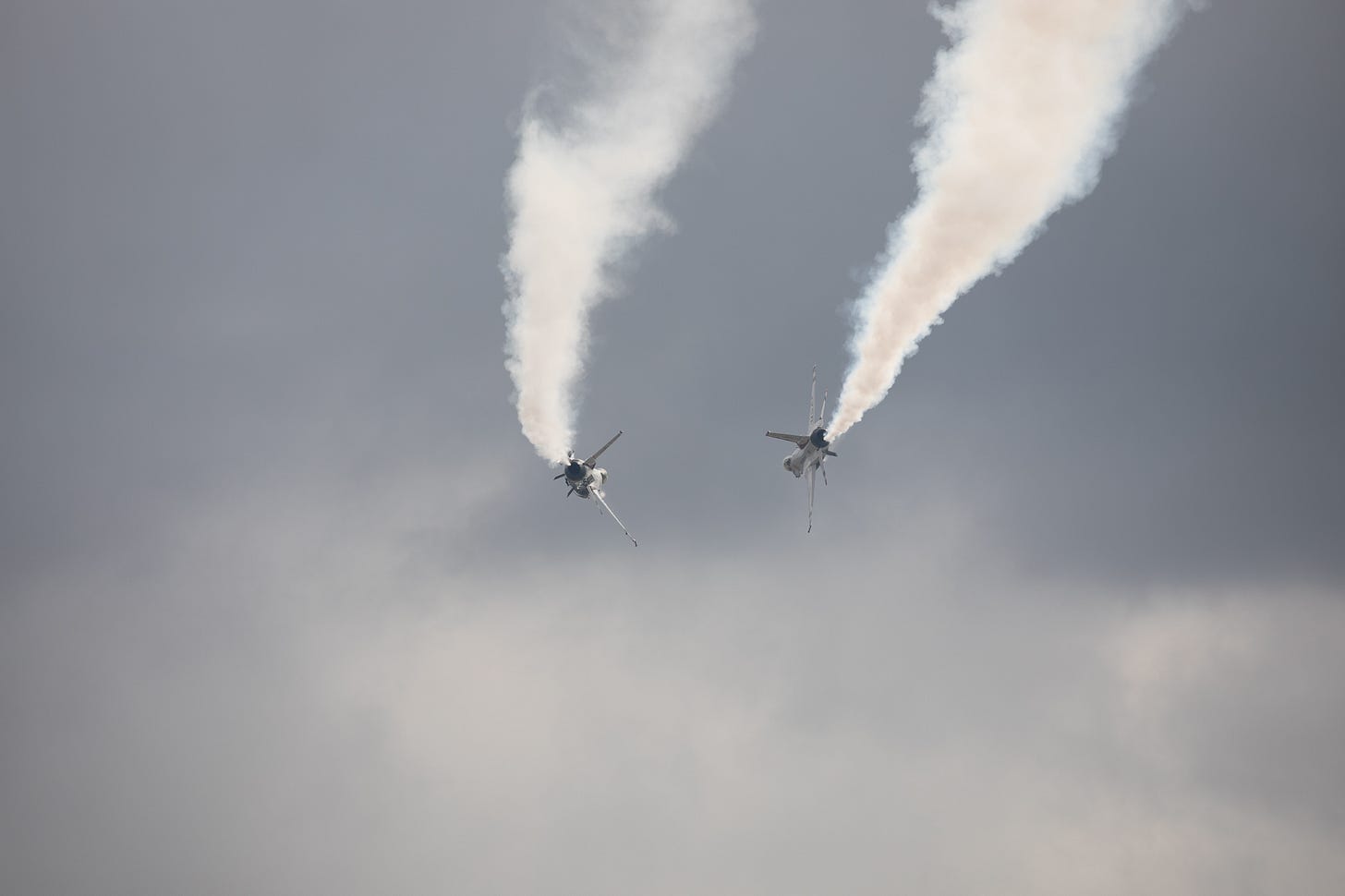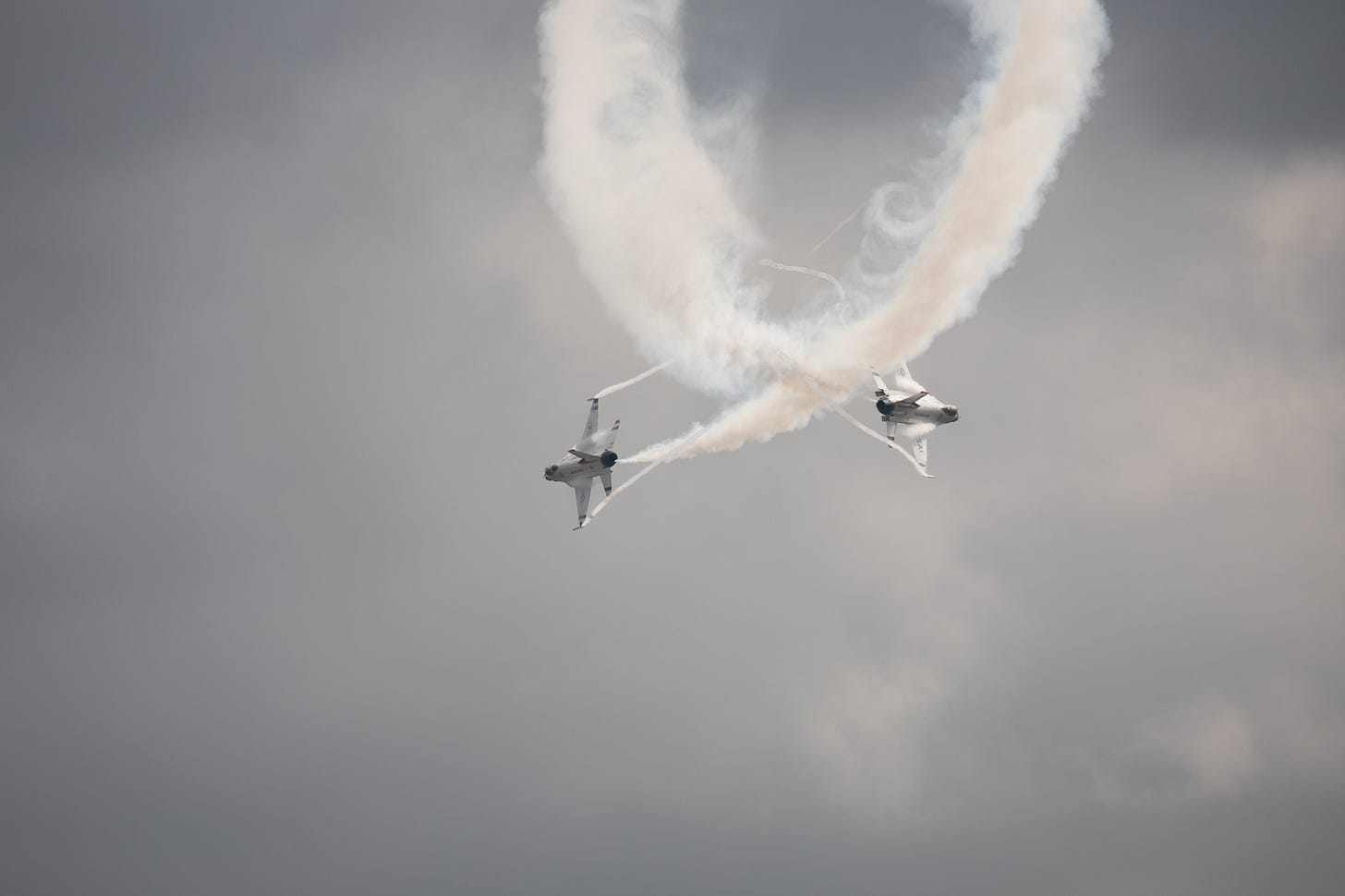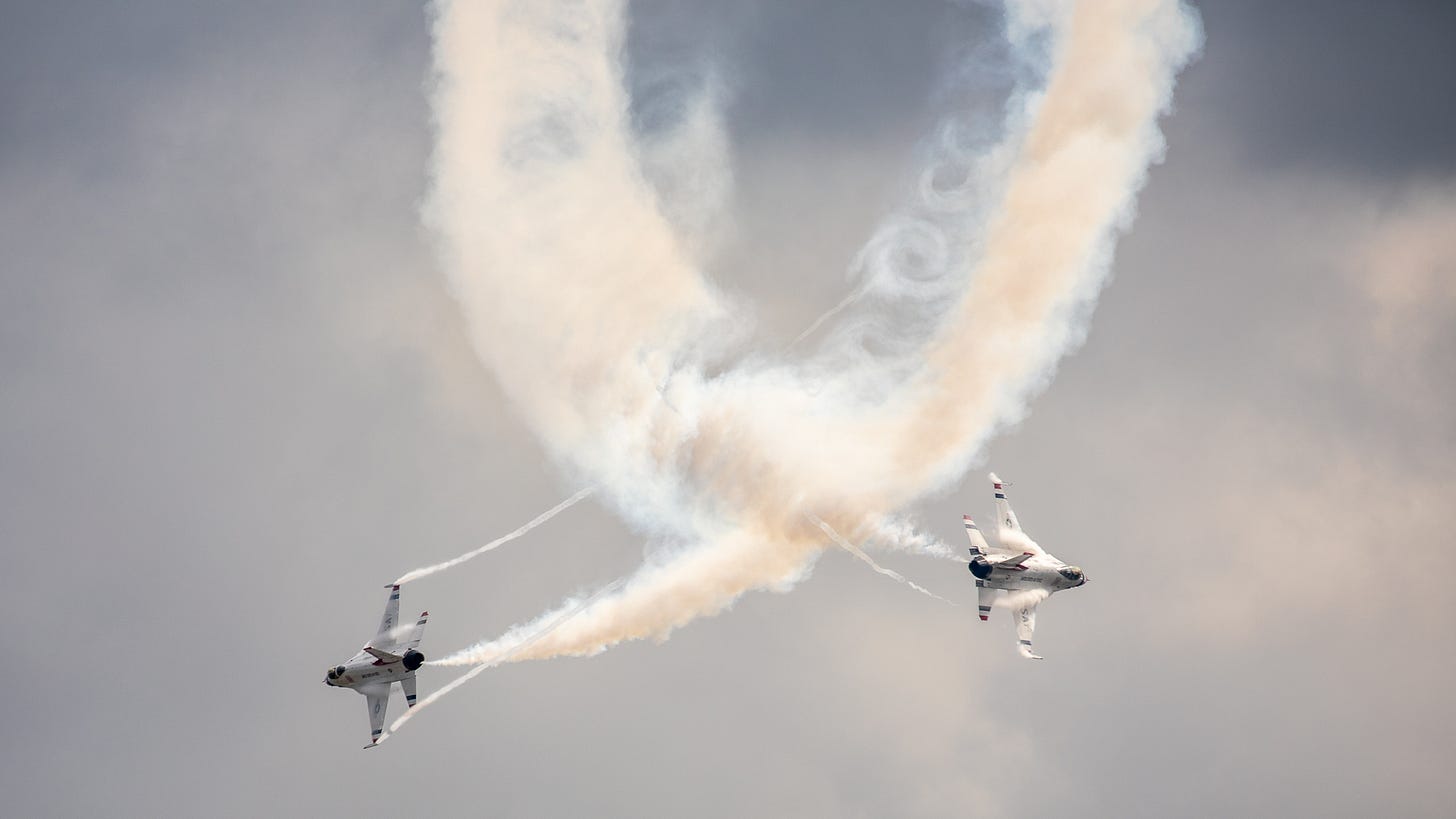Super Sabres, 100k, and the last flight of the first X plane
Remembering the F-100, a big milestone, and the X-1 flies its final flight
Let us never forget this: since the day of the air, the old frontiers are gone. When you think of the defense of England you no longer think of the chalk cliffs of Dover; you think of the Rhine. That is where our frontier lies.
-Stanley Baldwin, 1934
Mission Briefing
In the aviation world of the 1950s, as the sun rises on a new era, jet engines are transforming flight, and the pursuit of speed defines the decade. Today, as we celebrate a milestone of reaching 100,000 subscribers, let's delve into the aircraft that embodies speed, power, and innovation – the F-100 Super Sabre.
Imagine a post-World War II world hungry for progress. North American Aviation, renowned for their work on the P-51 Mustang and F-86 Sabre, dreams of breaking the sound barrier in level flight. However, transonic flight presents challenges, and the journey begins with the Sabre 45, named for its 45-degree wing sweep.
The YF-100's inception was marked by turbulence as engineers tirelessly worked to conquer transonic flight. With their unwavering determination, they designed the Super Sabre's wings with a 45-degree sweepback, coupled with a sleek fuselage, allowing it to gracefully reach Mach 1 in level flight. The F-100's design is nothing short of brilliance.
In 1953, less than a decade after World War II, the F-100 takes to the skies, surpassing expectations by reaching Mach 1.25 in level flight. However, it was a challenge to fly, resulting in accidents during testing and its early USAF service. After investigations and redesigns, the F-100 returned to flight status in 1955.
Amidst the rapid technological advancements of the 1950s and '60s, the F-100 stands out. It's not just about its powerful Pratt & Whitney J57 engine or advanced avionics; it's the fusion of design, capability, and mission role that sets the Super Sabre apart. It inspired a generation of pilots and became an aerial ambassador with the U.S. Air Force Thunderbirds.
Designated as F-100, it's sometimes referred to as the "hun," short for hundred. The F-100 is the first of the century series, representing a golden age in fighter plane development.
The F-100's story evolves with multiple iterations like the F-100C and F-100D, introducing aerial refueling, enhanced electronics, and increased payload capacity. It even takes on roles like reconnaissance and suppression of enemy air defense.
In Vietnam, the F-100 adapts to the demands of close air support, armed with rockets, bombs, and powerful cannons. Initially, it excels in this role, but as the war evolves, losses increase, leading to its replacement by the F-105 Thunderchief.
The F-100 Super Sabre broke barriers and set standards, symbolizing human achievement in aviation. Now, as we celebrate its journey from interceptor to Thunderbird and close air support attacker, we reflect on our own. Before YouTube, finding aviation enthusiasts was a challenge. This channel has evolved into an adventure driven by curiosity, passion, and a thirst for knowledge, thanks to your support.
This milestone of 100,000 subscribers is more than a number; it's a testament to a shared journey of storytelling, knowledge, and love for aviation. As the Super Sabre's legacy continues to inspire, may this channel do the same, with more stories to be told and aviation history to explore. Thank you for being part of this incredible journey.
F-100 video should be out to you by this Friday, be sure to check the channel!
This week in aviation history
6 November 1958: The Swan Song of the X-1 Program: A Milestone Flight That Closed an Era. Imagine you're a test pilot in the cockpit of a Bell X-1E rocket plane, suspended under the wing of a Boeing B-29 Superfortress. As you're dropped from the mothership over Edwards Air Force Base, your hand is on the throttle, ready to ignite the rocket engine for a momentous test. This was precisely the scenario for NASA Research Test Pilot John B. "Jack" McKay as he carried out the final flight in the X-1 rocket plane program—a program that had originated 12 years earlier.
Dropped from its carrier aircraft, the X-1E made its 26th and ultimate journey to test a new rocket fuel formulation. This legendary plane had come a long way from its predecessors, boasting a slimmer wing design, an improved fuel system, and an ejection-ready cockpit. The aircraft was wired with hundreds of sensors to collect vital data on air pressure and temperature.
Measuring 31 feet in length and with a wingspan of nearly 23 feet, the Bell X-1E weighed 6,850 pounds when empty and 14,750 pounds when fully fueled. Powered by a Reaction Motors XLR11-RM-5 rocket engine, this remarkable aircraft generated 6,000 pounds of thrust and carried enough propellant for a burn time of approximately 4 minutes and 45 seconds.
But after this final flight, a routine inspection discovered a structural crack in one of the bulkheads. The verdict was clear; the X-1E had flown its last. With this decision, the curtain fell on a program that had been instrumental in pushing the boundaries of supersonic flight.
This rocket plane program, originally sponsored by the National Advisory Committee on Aeronautics (NACA)—the organization that would later evolve into NASA—was a sequel to the X-1 aircraft that Charles E. "Chuck" Yeager famously piloted to break the sound barrier back in 1947. While Yeager's "Glamorous Glennis" was designed to explore high subsonic and low supersonic speeds, later iterations like the X-1D and the X-1E were crafted to investigate the effects of aerodynamic heating in the higher supersonic ranges, from Mach 1 to Mach 2.
In total, 236 flights were conducted under the X-1 banner, including the X-1A, X-1B, X-1D, and X-1E variants. These flights laid the groundwork for our understanding of supersonic aerodynamics and paved the way for future high-speed, high-altitude flight. The X-1 program serves as a testament to human innovation and the quest to push technological boundaries.
So, as we reminisce about the final flight of the X-1 program, piloted by Jack McKay, we not only look back at a single mission but also celebrate the end of an era that significantly shaped aviation history.
In case you missed it
Looking back, this F-18 video, and its second part was the turning point for my channel:
Photo Outlet
Timing is everything in photography. Here is a sequence of the two solo Thunderbirds performing their famous crossover maneuver:
Post Flight Debrief
It took my channel just over 6 years to reach the 100,000-subscriber mark - what began as a hobby has turned into a way of life for me and my livelihood - I cannot express enough how thankful, humbled, and fortunate I am. With every video, newsletter or social media post I try and capture my love and fascination for aviation. Similar to when you receive your first pilots license, this milestone is not an end, but a license to learn. I will strive to get better at storytelling, animation, editing, pacing, to bring you the joy I feel with each video. Thank you for being here, reading this, and now you know.
That’s all for this week, thanks for reading! If you know a fellow aviation enthusiast that would enjoy these weekly newsletters, then please forward this along. Now you know!
-Tog










